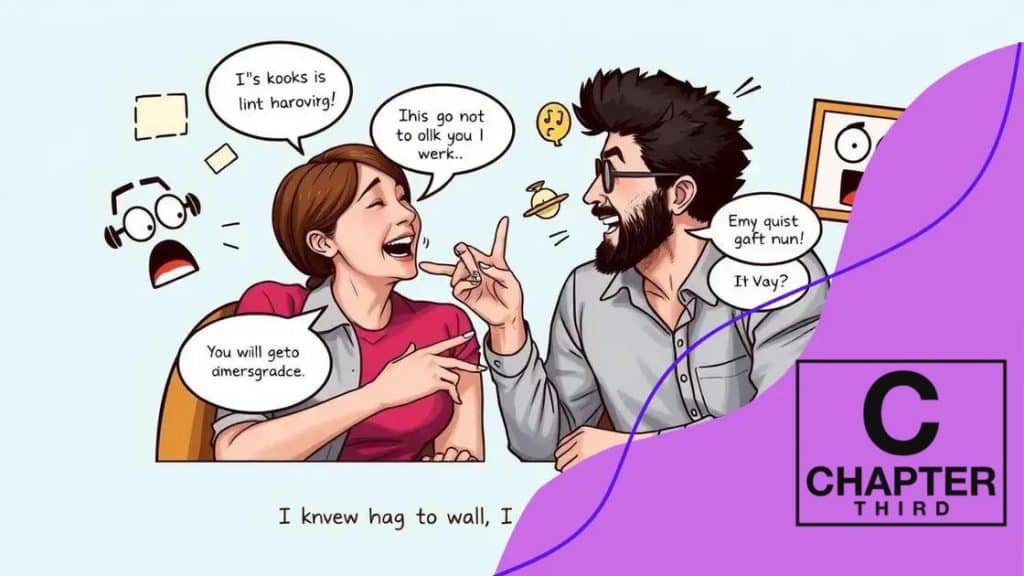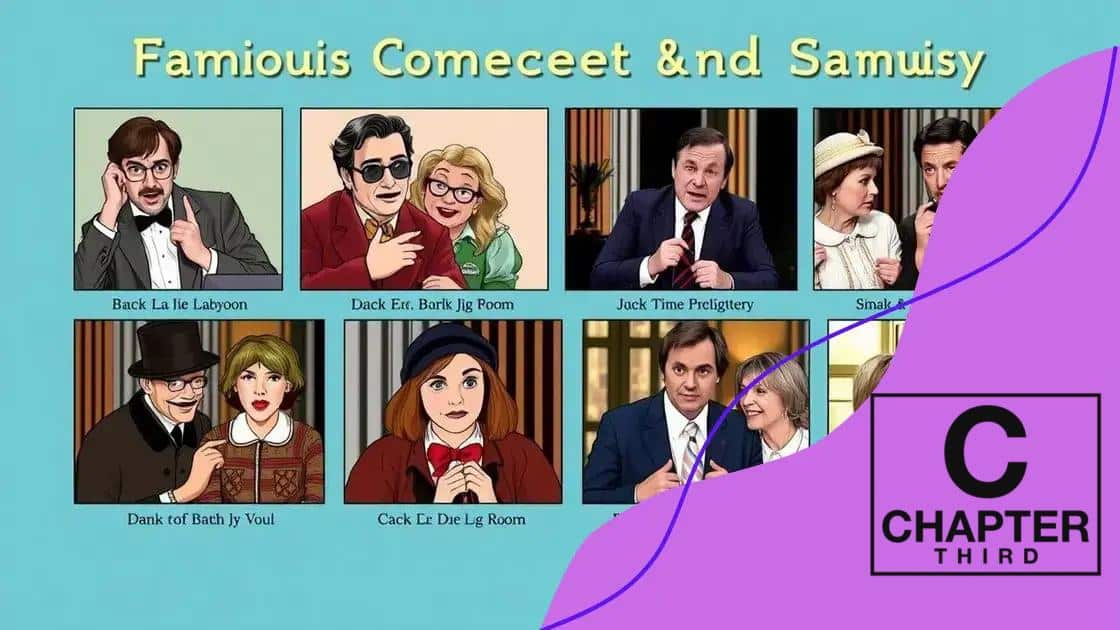Comedy of errors and misunderstandings: a closer look

Comedy of errors and misunderstandings showcases how humor can effectively diffuse conflicts and enhance communication by reflecting real-life mistakes, enabling a healthier resolution of disagreements.
Comedy of errors and misunderstandings has a way of capturing our attention and tickling our funny bones. Have you ever found yourself in a mix-up that later turned into a good laugh? Let’s explore how these comical situations unfold.
Understanding the concept of comedy
Understanding the concept of comedy is essential to appreciating how laughter can arise from our daily lives. At its core, comedy often stems from a contrast between reality and expectations, leading to unexpected outcomes that tickle our funny bones.
When we think about what makes something funny, we often find ourselves considering various elements. Timing is crucial; knowing when to deliver a punchline can make all the difference. Exaggeration is another key aspect; it allows us to amplify situations to absurdity, making them more humorous. Moreover, relatability helps the audience connect with the humor, as they can see reflections of their own lives in the comedy presented.
Types of Comedy
There are several styles of comedy that we encounter. Each has its unique flair and appeal:
- Physical Comedy: Involves visual gags and exaggerated movements.
- Satire: Uses humor to critique social issues and cultural norms.
- Dark Comedy: Finds humor in serious or taboo subjects.
- Romantic Comedy: Blends humor with romantic situations.
These various forms highlight how comedy can reflect different aspects of society. For instance, satire often pushes boundaries, encouraging audiences to think critically about serious topics. Likewise, physical comedy relies less on dialogue and more on visual performance, enabling it to transcend language barriers.
As we delve deeper into comedy, it’s important to note how misunderstandings fuel much of it. When characters misinterpret scenarios or make incorrect assumptions, the ensuing chaos leads to hilarity. This is particularly evident in *farces*, where elaborate misunderstandings create a domino effect.
The Role of Context in Comedy
The context in which comedy is delivered plays a significant role. Cultural nuances and social settings influence what jokes land or fall flat. For example, a joke that works in one culture may not resonate in another. This highlights the importance of understanding your audience. As humor evolves, so do the perspectives from which it is derived.
Ultimately, comedy helps us navigate life’s complexities. Whether through laughter or light-hearted frustration at miscommunication, it serves as a tool for connection. By understanding the nuances of comedy, we can appreciate the myriad ways it reflects our own experiences and the world around us.
Common scenarios of misunderstandings
Common scenarios of misunderstandings often arise in our daily interactions, leading to amusing yet relatable situations. These scenarios can happen anywhere, whether at work, home, or during casual conversations. They remind us how easily communication can go awry.
One typical example is when friends make plans but misinterpret each other’s intentions. For instance, if one friend suggests going to a movie, but another thinks it’s a dinner invitation, the result can be a hilarious mix-up. Such misunderstandings not only lead to laughs but also strengthen friendship bonds when resolved.
Workplace Misunderstandings
In the workplace, misunderstandings can have amusing consequences. Consider a situation where colleagues discuss a project, but one misunderstands the assigned roles:
- Miscommunication on Roles: One person thinks they are leading, while another assumes they are in charge.
- Emails Gone Wrong: Jokes taken literally can cause confusion in written communication.
- Office Humor: A light-hearted comment may be misinterpreted as criticism.
These examples showcase how humor can help navigate tricky work dynamics. Often, when the misunderstanding is unveiled, team members can laugh about the situation, fostering a positive work environment.
Another frequent scenario occurs in familial settings. Family members may misinterpret each other’s actions or words, leading to light-hearted disputes. For example, a child might think a parent is upset when in fact they are just concentrated on a task. The resulting confusion often leads to amusing attempts to clear the air.
Everyday Conversation Blunders
Everyday conversations are ripe with potential for misunderstanding. For instance, someone may use a phrase or slang that has a different meaning in another context. A simple joke might be taken seriously, leaving both parties perplexed. The beauty of these blunders lies in the shared laughter that usually follows.
As we share these experiences, they serve as a reminder of our shared humanity. Misunderstandings often lead to funny stories that we recount later, bonding us through laughter.
Famous examples in literature and film

Famous examples in literature and film showcase how comedy can effectively highlight misunderstandings. Many beloved stories feature characters in awkward or funny situations that arise from miscommunication. These examples resonate with audiences, allowing them to see their own experiences reflected in the narrative.
One significant example is Shakespeare’s *A Comedy of Errors*, where twin brothers and their servants create chaos in the city of Ephesus. The resulting mix-ups and mistaken identities generate a series of comedic physical mishaps. The genius of this play lies in its ability to continuously surprise the audience while keeping the humor relatable.
Classic Films
Classic films also highlight misunderstandings for comedic effect. Movies like *Some Like It Hot* involve characters disguising themselves to escape danger, leading to hilarious complications because of mistaken identities. These scenarios reveal how misunderstandings can spiral into side-splitting comedy, allowing the audience to enjoy the unfolding chaos.
- Monty Python and the Holy Grail: The absurdity of knights on a quest, often misinterpreting their surroundings.
- The Hangover: A bachelor party gone wrong, with misunderstandings leading to outrageous situations.
- When Harry Met Sally: The miscommunication between friends highlighting romantic misunderstandings.
These films engage audiences by showing how misunderstandings can lead to unexpected and humorous outcomes. Viewers relate to these comedic tropes because they mirror real-life situations, even if the circumstances are exaggerated.
Literary Works
In literature, misunderstandings abound in stories like Jane Austen’s *Pride and Prejudice*. The misjudgments between Elizabeth Bennet and Mr. Darcy lead to witty exchanges filled with irony. This essential conflict creates delightful tension that not only engages readers but also leads to various humorous moments.
Moreover, in modern literature, works like *The Hitchhiker’s Guide to the Galaxy* exemplify how misunderstandings between intergalactic travelers create comical situations. The absurdity of character interactions reflects real-life challenges and the comedic potential of poor communication.
In all these examples, the interplay of misunderstanding and comedy serves to create engaging narratives that resonate with readers and viewers alike. By recognizing these comedic elements, audiences can better appreciate the laughter that emerges from everyday blunders.
How comedy reflects real-life errors
How comedy reflects real-life errors is an intriguing aspect of humor. Everyday life is filled with mistakes, and these blunders can provide rich material for comedic expression. Comedy often takes a light-hearted approach to serious situations, allowing us to laugh at our imperfections.
One of the fascinating elements of comedy is how it mirrors the errors we all make. For instance, when characters slip on a banana peel or accidentally mix up identities, it resonates because these types of mishaps happen in our lives too. When we witness such situations in comedy, it highlights how universal and relatable human errors are.
Comedic Situations
Comedy captures various real-life errors through relatable situations:
- Misunderstandings: Simple miscommunications, like a joke taken seriously, can create funny scenarios.
- Physical Gags: Mistakes involving physical comedy, such as tripping or spilling, remind us of our clumsiness.
- Awkward Social Interactions: Navigating social norms can lead to embarrassing situations, which comedy often exaggerates.
These elements show that comedy is not just about laughter; it’s about connecting with the audience’s own experiences. Mistakes are a part of being human, and when comedy reflects these moments, it helps us cope with our flaws.
Learning Through Laughter
Moreover, by presenting errors humorously, comedy allows us to learn without feeling ashamed. It’s easier to embrace our shortcomings when we see them portrayed humorously in film or literature. For instance, a character’s ridiculous blunders can remind us to approach our mistakes with a sense of humor.
In many comedy routines, artists share anecdotes from their lives, revealing their own errors and how they dealt with them. These stories create a shared experience, reminding us that we are not alone in our struggles.
Ultimately, comedy serves as a mirror, showing us that everyone makes mistakes. By laughing at our errors, we can find joy in our journey of self-discovery and growth.
The impact of humor on resolving conflict
The impact of humor on resolving conflict is significant and often underappreciated. Humor can act as a powerful tool that helps to de-escalate tense situations. When conflicts arise, laughter can diffuse anger and create a more positive atmosphere.
In many cases, when people find common ground through shared laughter, it can lead to better communication. For instance, during a disagreement, a light-hearted joke can remind everyone involved that they are on the same team. This shift in perspective can help break down barriers and open channels for dialogue.
Benefits of Humor in Conflict Resolution
Incorporating humor into conflict resolution can have several benefits:
- Lowers Tension: Humor eases the mood, making it easier for individuals to discuss serious topics without feeling defensive.
- Encourages Open Communication: When people laugh together, they feel more comfortable expressing their thoughts and feelings.
- Builds Rapport: Shared laughter strengthens relationships, reinforcing connections among individuals.
These benefits exemplify how humor serves not just to entertain but also to mend relationships and foster understanding.
Examples of Humor in Conflict
Several real-world examples illustrate humor’s effectiveness in conflict resolution. Take, for example, the workplace scenario where colleagues might disagree on a project. A well-timed joke can ease the tension, allowing for brainstorming without heated arguments. Similarly, couples can use humor to navigate disagreements, finding ways to laugh rather than argue.
Another example is in mediation sessions, where humor can help bridge gaps between opposing sides. Mediators often use lighthearted comments to create a friendly environment, making both parties feel more at ease. This can pave the way for a more successful resolution.
Ultimately, humor can transform conflict into cooperation. By allowing laughter to nurture understanding, we can address disagreements more effectively.
FAQ – Questions about the impact of humor on misunderstandings and conflict resolution
How does humor help to resolve conflicts?
Humor lightens the mood, easing tensions and fostering open communication between parties.
Can laughter improve relationships?
Yes, shared laughter can strengthen bonds, making it easier to navigate disagreements.
What are some examples of humor in conflict resolution?
Situations like a well-timed joke during a disagreement or humorous anecdotes can diffuse tension.
Is humor effective in professional settings?
Absolutely! Humor can help create a positive workplace atmosphere, improving teamwork and collaboration.





